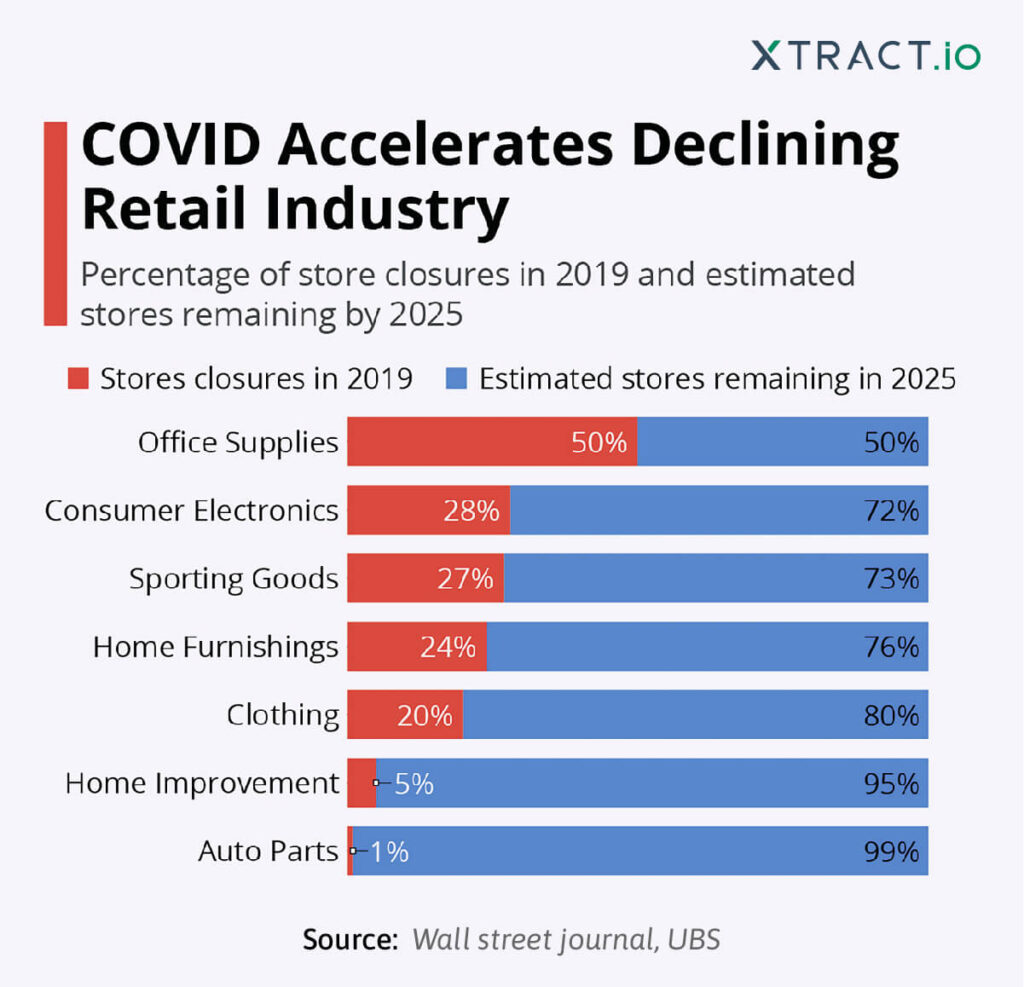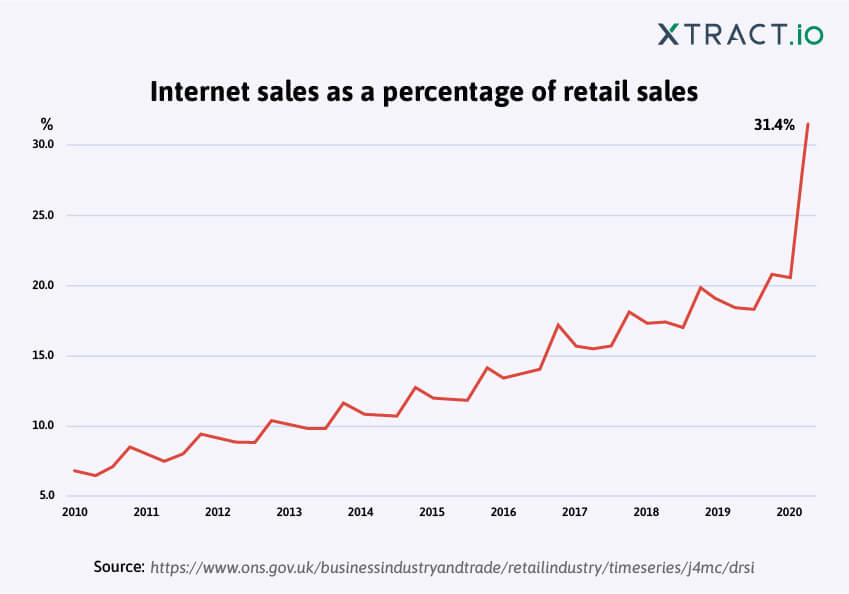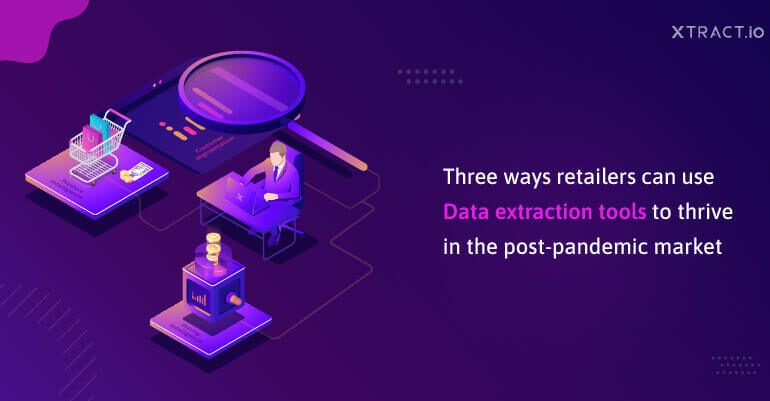COVID-19, the global pandemic, has sent financial shockwaves around the world. The retail industry was hit the hardest, as physical stores were forced to close down to control the pandemic.
According to a Deloitte report, “ Retail productivity plunged 20 percent from February to April, with substantial declines in categories like clothing, accessory stores, and department stores”.
Traditional retailers who conducted business from a physical location saw their profits plummet. Concurrently, the digital industry began to flourish.
In the digital world of shopping, every customer touchpoint generates a massive amount of data, which, when properly analyzed, can help the retailers understand their customers better. Data extraction tools would help retailers capture critical customer information to comprehend the current trend, allowing them to emerge stronger than before and deploy successful business models.
Trends in the retail industry
Due to the advent of many new players and technologies, retail has emerged as the world’s fastest-growing industry. The customer purchasing pattern in the retail sector has changed rapidly since the introduction of smartphones and the internet.
There is no doubt that the digital revolution in retail has altered the way customers discover, evaluate, and purchase products. The social media platform has also become one of the essential sources for many online purchases. According to a 2018 Global Consumer Insights survey, 37 percent of customers viewed social media platforms as the primary motivator for purchasing a product.
According to a Harvard Business Review article, brick and mortar stores still account for 94-97 percent of retail sales despite the hype surrounding the E-commerce industry. Both physical stores and online platforms attract different types of customers. So, combining a solid retail online presence with a robust physical store would accelerate the sales curve.
The Retail Sector and COVID 19
The global economy, which had slowed in 2019, had collapsed entirely by 2020. Even before the virus’s impact, the retail industry’s sales fell between 2019 and 2020. The novel coronavirus has fundamentally altered the retail sector’s operations.

According to a Forbes article, 49 percent of customers shop online more now than they did previously. A few years ago, retailing was all about walking into a store, trying on a product, and then purchasing it from the store.
As a result of the store closures and shoppers’ constant fear of contracting the Coronavirus, a large population has shifted to online shopping.

People have become accustomed to the “new normal” lifestyle and are less likely to return to their pre-COVID way of living. Customers would demand that the retail industry reduce physical interaction.
So, retailers should consider investing in tech infrastructure and technologies that ensure the safety of both customers and employees. In contrast, online retailers should develop advanced AR/ VR shopping experiences to nurture the customer.
Why should retailers use a data extraction tool?
There is a lot to keep track of in the post-pandemic world, from tracking customer behavior to deploying business strategies. Analyzing the purchase pattern and the customer psychology would demand massive amounts of data. Manually extracting and analyzing all this data would require a lot of effort and resources. Integrating an AI and ML-based data extraction tool would help capture and analyze data automatically, providing meaningful business insights to retailers.
How can data extraction help boost productivity post-pandemic?
It is essential to meticulously collect data from multiple sources and devise strategies based on the right mix of customer data to increase customer retention rate.
Here are some use cases of how you could use data extraction:
Customer segmentation
As a retailer, it is indispensable to segment the customers based on internal data such as the purchasing history, frequency of purchase, and in contrast, online external data such as the name, age, and demographic details. The extensive segmentation enables you to analyze each customer’s purchasing behavior and create marketing campaigns accordingly.
The automated data extraction process collects both micro and macro segment customer details and provides you with a comprehensive understanding of the customer, allowing you to outperform the competitors.
Product intelligence
Retailers offer a diverse range of products both online and in-store. It is critical to have a clear picture of the best-selling products and the products that are in high demand. Anticipating demand for each product and duly stocking them will save you from having to manage inventory. It would also help you deliver the product that the customer requires on time, resulting in customer satisfaction.
Having a thorough understanding of each product’s performance would aid in the development of new marketing strategies. An automated data extraction tool extracts information about each product in the retail unit and analyses the data to assist you in forecasting product demand.
Pricing intelligence
There is a global economic downturn, and the general public has significantly less cash flow. The product’s pricing should be done wisely based on current market conditions to attract customers. The company’s pricing strategy is directly related to its customer retention rate.
When a competitor offers a lower price than you for the same product, you risk losing your loyal customers and failing to attract new customers. So, monitoring your competitor’s pricing strategies and setting the best price for your products is essential in gaining a competitive advantage in the market.
An AI-powered data extraction tool gathers information from multiple sources about your competitors’ pricing strategies for similar products, profit margins, and market demand. It will assist you to remain competitive and strike a balance between customer retention and profit generation.
Conclusion
It is always essential to identify unhappy customers and reduce customer churn to increase business profitability. The key to customer retention and attraction is to analyze each customer’s data and target them with the appropriate marketing campaigns. The correct data, extracted and analyzed at the right time, has the desired effect on the intended audience.
Customer expectations and needs have been completely altered as a result of the pandemic. You don’t want to miss out on potential customers because you don’t have access to the correct data.
Our AI and ML-enabled data extraction tool would assist you in extracting data from disparate sources and analyzing trends, competitors, and the market, as well as anticipating demand. With our unstructured data extraction tool, you can tap the data potency and push your profit curve higher!








1 Comment
That was really informative! Data extraction tools like Digital Resume Parser and Affinda help you extract the most relevant data in the shortest time.